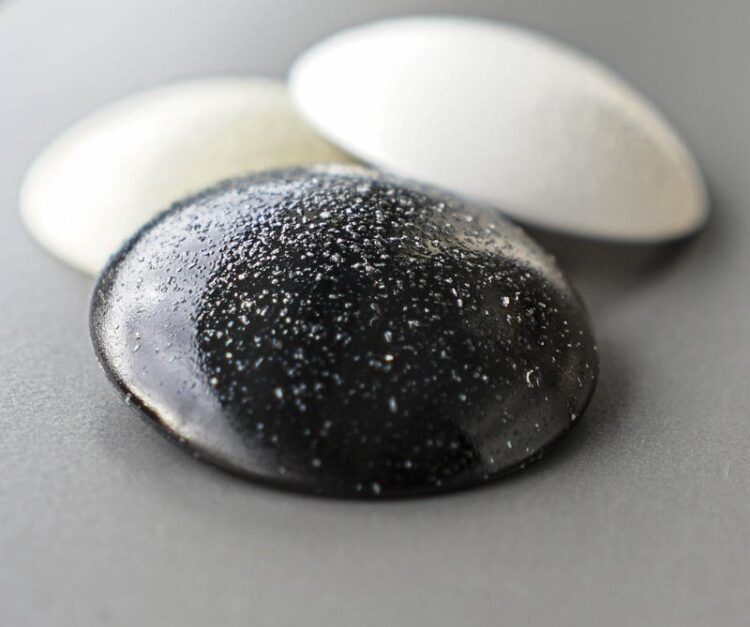With remains of crustaceans against bacteria and viruses

Example of an antibacterial surface including chitosan.
Hochschule Hof
An exciting research project with current relevance and a wide range of possible applications is currently underway at Hof University of Applied Sciences: The Institute for Material Sciences (ifm) is doing research on antibacterial surface coatings. In the future, these paint compounds are going to be used in hospitals, doctors’ surgeries or even in public transport systems in particular and will inhibit the spread of bacteria and viruses. For the first time, a natural substance, which can be obtained by the remains of crustaceans that has been little used so far, will help.
Jessica Wittmann (31) is a research assistant in the research project “hospital bed” at Hof University of Applied Sciences. Together with two colleagues, the industrial mechanic with a degree in materials engineering, who also holds a master’s degree in applied surface and material sciences, has set herself the task of actively researching against a problem that is currently on everyone’s lips worldwide: By new types of paint coatings, the researchers in Hof want to inhibit the spread of bacteria and viruses on surfaces – especially in highly frequented and therefore hygienically critical areas.
Despite the name of the project, hospital beds are only one of many possible applications.
“Although there are already coatings that have an antibacterial effect. However, these contain substances that have been heavily criticized for their effect on humans – take varnishes with nano-silver, for example. We want to replace these substances with skin-friendly natural raw materials. And ideally with the same or even a better effect,” says Jessica Wittmann explaining her research approach.
A very special substance that has been found in some dental cleaning products, pesticides and medical devices is expected to help in this process: chitosan. This natural biopolymer is found in the shells of crustaceans and can have antimicrobial, antibacterial and antiviral effects. Obtained from the remains of crustaceans in a multi-stage process, it reaches the Hof laboratory in form of a white powder. The right methods for further processing, the correct dosage and, last but not least, the best possible incorporation into the surface coating are what Jessica Wittmann and her colleagues are then occupied with within of many test series. During this process, the researchers still have to deal with a whole range of unknowns:
“We don’t know yet: Does chitosan work best as a powder, in particle form or otherwise dissolved? It is also unclear which dosage will be sufficient to ultimately achieve the best possible antibacterial effect,” says Wittmann, who worked for four years in the development department of a well-known polymer specialist in Upper Franconia before joining the team at Hof University.
The question of dosage, i.e. how much chitosan is needed per square meter of surface area, can ultimately also decide whether the finished product actually finds its way into everyday life in hospitals, doctors’ offices or buses – after all, the process of extracting the substance is quite complex and therefore expensive. So far, there are no empirical values for this, because the introduction of chitosan into coating materials is still in its infancy. “However, we hope that it can also develop its known effect in relatively small concentrations, so that industrial use will be possible later,” says Jessica Wittmann optimistically.
The research project should be completed by the middle of 2022. It is under the technical direction of Prof. Dr. Jörg Krumeich, who is responsible for the area of materials engineering and surface technology in the Faculty of Engineering at Hof University of Applied Sciences. The project is funded by the Central Innovation Program for Medium-Sized Enterprises (ZIM). As an industrial partner, lacolor Lackfabrikation GmbH, a company experienced in the field of industry, supports the researchers from Hof University.
Wissenschaftliche Ansprechpartner:
Prof. Dr. Jörg Krumeich
Hochschule Hof
Alfons-Goppel-Platz 1
95028 Hof
Fon: +49 (0) 9281 / 409 4550
E-Mail: joerg.krumeich@hof-university.de
Media Contact
All latest news from the category: Materials Sciences
Materials management deals with the research, development, manufacturing and processing of raw and industrial materials. Key aspects here are biological and medical issues, which play an increasingly important role in this field.
innovations-report offers in-depth articles related to the development and application of materials and the structure and properties of new materials.
Newest articles

NASA: Mystery of life’s handedness deepens
The mystery of why life uses molecules with specific orientations has deepened with a NASA-funded discovery that RNA — a key molecule thought to have potentially held the instructions for…

What are the effects of historic lithium mining on water quality?
Study reveals low levels of common contaminants but high levels of other elements in waters associated with an abandoned lithium mine. Lithium ore and mining waste from a historic lithium…

Quantum-inspired design boosts efficiency of heat-to-electricity conversion
Rice engineers take unconventional route to improving thermophotovoltaic systems. Researchers at Rice University have found a new way to improve a key element of thermophotovoltaic (TPV) systems, which convert heat…



